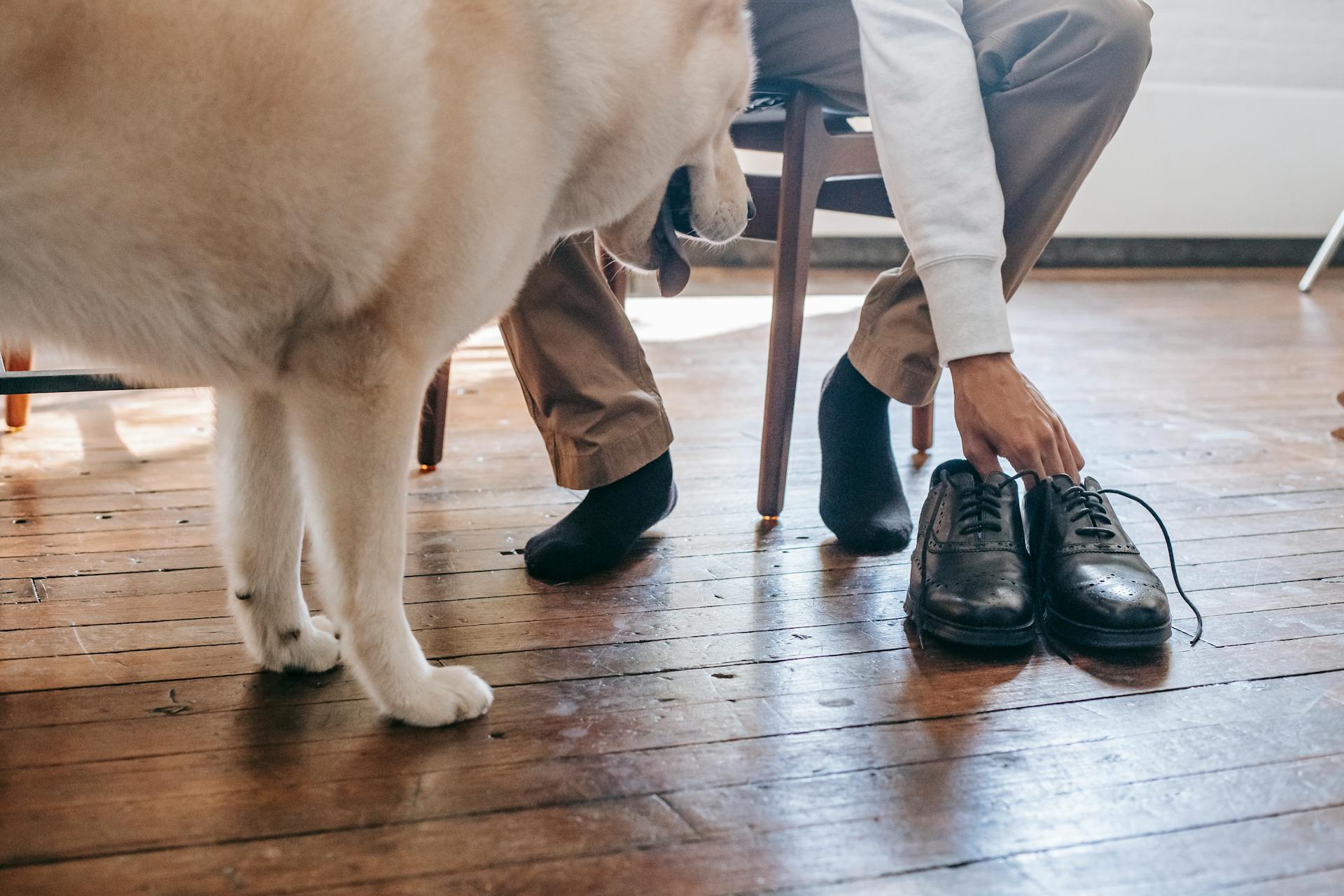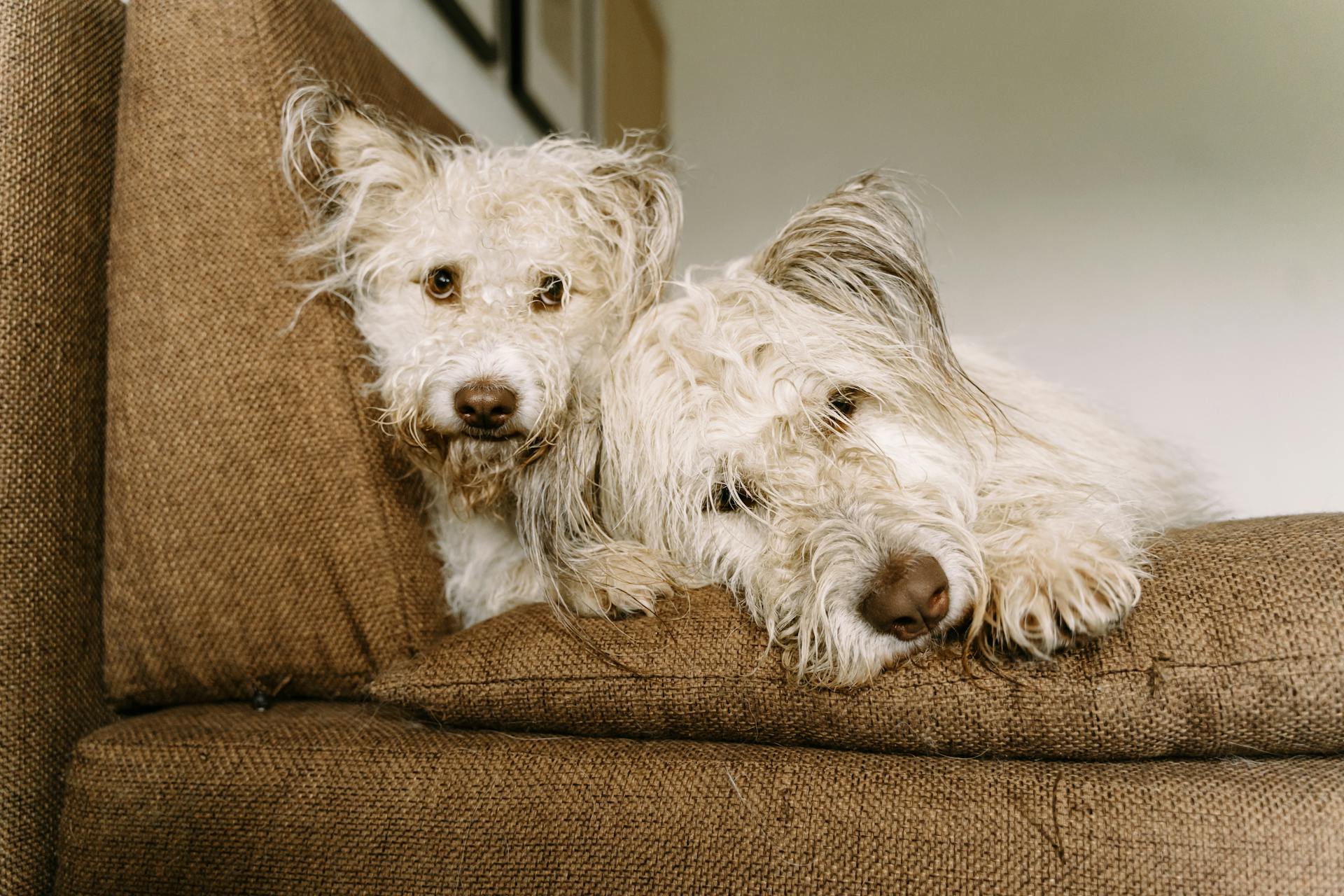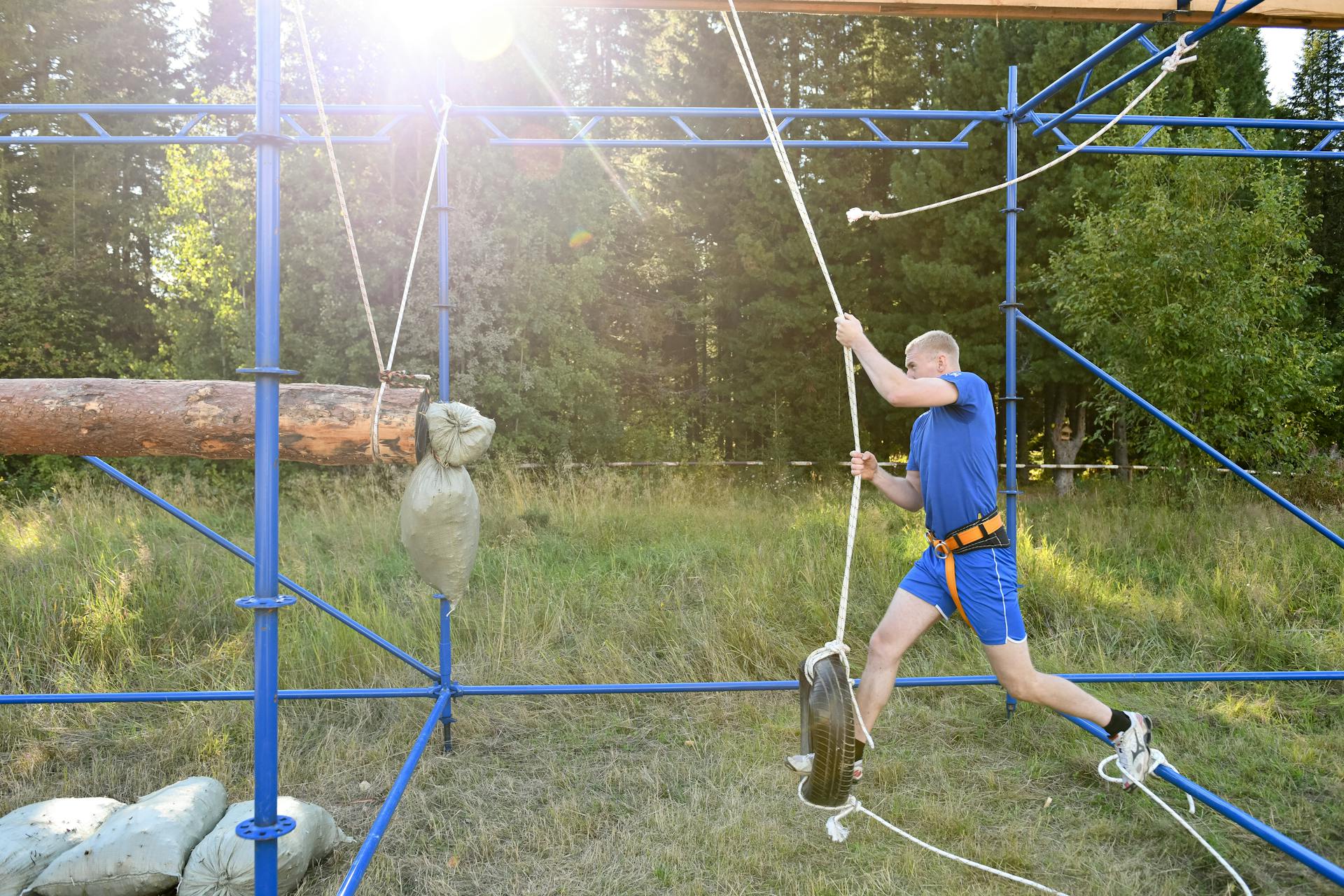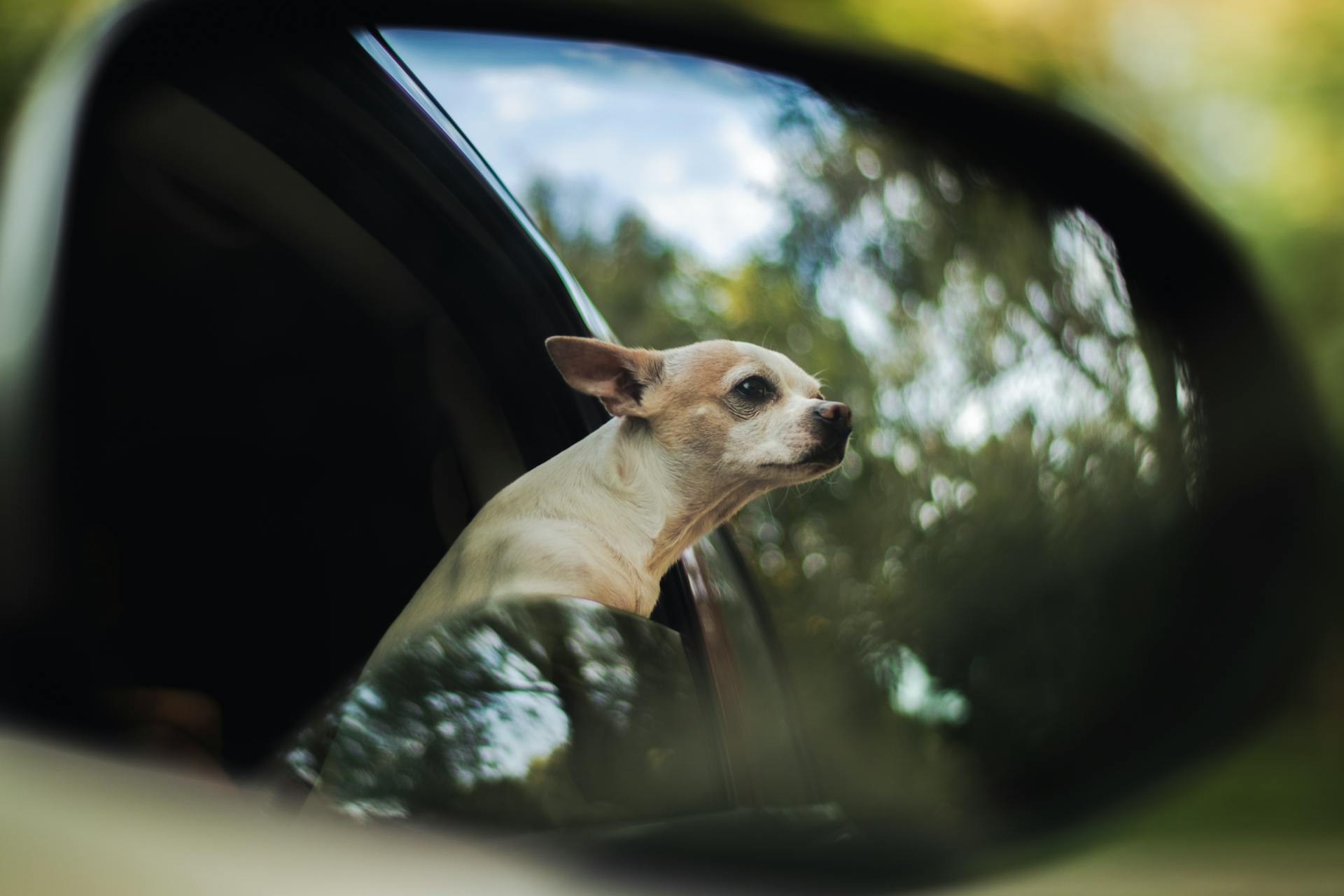
Separation anxiety in dogs is a common issue that can be distressing for both dogs and their owners. According to research, 14.9% of dogs in the US suffer from separation anxiety.
The first sign of separation anxiety in dogs is often destructive behavior, such as chewing or digging, which can be a result of boredom or anxiety. This behavior can be triggered by a change in the dog's environment or routine.
Some dogs may also exhibit vocalization, such as barking or whining, when left alone. In fact, studies have shown that 70% of dogs with separation anxiety exhibit vocalization.
To prevent separation anxiety in dogs, it's essential to establish a consistent routine and provide mental and physical stimulation.
What is Separation Anxiety in Dogs?
Separation anxiety in dogs is a unique condition that occurs when your dog is left alone and becomes excessively stressed. This stress can manifest in destructive behavior like tearing through a crate, couch, or even a wall.
It's not just about boredom or generalized anxiety, but rather a deep-seated fear of being left alone and the unknown that follows. Animals live in the present moment, so when you leave, they may think you're gone forever.
Symptoms of separation anxiety can vary, but dogs will often act as if they're terrified to be in the house on their own, exhibiting extreme stress from the time you leave until you return. This can be likened to a panic attack, and it's not just a minor issue, but a serious condition that can lead to frustration and even giving up your dog.
Separation anxiety happens when a dog becomes hyper-attached to their owner and gets super-stressed when left alone. It's more than just a little whining or mischief while you're out, but a serious condition that requires attention and help.
Readers also liked: Training Dog Not to Bark at Doorbell
What Causes?
Separation anxiety in dogs can stem from various reasons, with some dogs developing it due to physical illnesses that cause moderate to severe discomfort.
Senior dogs and dogs with cognitive dysfunction syndrome (CDS) can develop separation anxiety.
Dogs recently adopted from shelters may also develop separation anxiety, but it tends to develop 1-2 months after being brought home.
Giving a dog too much attention prior to leaving or when returning can raise their anxiety levels during these times.
Changes in environment, such as moving or introducing new family members or pets, can trigger separation anxiety.
Dogs with unknown backgrounds may have causes that are difficult to determine, as it is impossible for owners to know all the details of their dog’s life before adoption.
Some research has even pointed to a lack of daily exercise as a possible cause of separation anxiety.
Traumatic separation, such as being abandoned in a shelter, can also lead to separation anxiety.
A single traumatic event in the owner’s absence, like the house being robbed, can lead to separation anxiety.
Signs and Symptoms
Dogs with separation anxiety tend to vocalize when they're left alone, often barking, whining, or howling excessively. This can be a sign of distress and may cause trouble with neighbors or landlords.
Vocalization is a common symptom of separation anxiety in dogs, and it can begin before separation if they learn to anticipate their owner's departure. Dogs may also pant and salivate excessively, which can lead to accidents within the house.
Some dogs with separation anxiety may exhibit destructive behavior, such as chewing on door frames or furniture, which can cause lasting property damage. In extreme cases, this behavior can even lead to veterinary emergencies.
Here are some common signs and symptoms of separation anxiety in dogs:
- Excessive panting and salivation
- Excessive barking or howling
- Destructive behavior
- Urination or defecation around the house
- Trembling or salivating
- Digging and scratching at doors or windows
- Destructive chewing
- Howling, barking or whining
- Urination and defecation (even with otherwise house-trained dogs)
These behaviors can be a sign that your dog is experiencing separation anxiety and may need attention and treatment to manage their stress.
Medical and Behavioral Problems
Before treating your dog for separation anxiety, it's essential to rule out other behavioral issues that have overlapping symptoms. Many behavioral problems in dogs can mimic separation anxiety, making it crucial to identify the underlying cause.
Separation anxiety is often confused with other conditions that cause destructive behavior when left alone. It's not uncommon for owners to mistake separation anxiety for a dog's need for exercise or attention.
To rule out other behavioral issues, consult with a veterinarian or a certified animal behaviorist who can help you identify the root cause of your dog's behavior. They can also provide guidance on the best course of action.
In some cases, separation anxiety can be so severe that it requires medication to manage. Your veterinarian may prescribe anti-anxiety medication to help bring your dog's anxiety baseline down, making it easier to implement behavior modification techniques.
Diagnosis and Treatment
Diagnosing separation anxiety in dogs can be a challenging process, but it's essential to determine the underlying cause of the condition. This typically involves a veterinarian observing a dog's behavior within the first 15 to 30 minutes after an owner's departure.
A veterinarian will try to determine the underlying cause of separation anxiety, which can take time, especially if it's medical in nature. This process may involve blood work, diagnostic imaging, or a referral to a board-certified veterinary behaviorist.
Treatment for separation anxiety is often a combination of medication, calming aids, and behavior modification. Anti-anxiety medications like clomipramine or fluoxetine may be prescribed, along with calming aids like pheromones or products like Anxiety Wrap or Thunder Shirts.
Consider reading: Healthy Mind Canine - Separation Anxiety Training
Diagnosing

Diagnosing separation anxiety in dogs is based on a dog's symptoms and behavior. Videoing a dog during the first 15 to 30 minutes after an owner's departure can help your veterinarian in the diagnosis.
Dogs usually exhibit symptoms of separation anxiety within this timeframe. Your veterinarian will try to determine the underlying cause of the condition, especially if it's medical in nature.
The underlying cause may not be immediately evident, and determining it can take time. Your veterinarian may recommend blood work, diagnostic imaging, or refer you to a board-certified veterinary behaviorist.
Diagnosing separation anxiety in dogs is dependent on clinical signs. If your veterinarian diagnoses your dog with separation anxiety, they will then attempt to find the underlying cause of the condition.
Treatment Options
Treating separation anxiety takes time and patience, but with the right approach, your dog can learn to cope.
Medications like clomipramine and fluoxetine can help alleviate symptoms, especially if the underlying cause is medical.

Behavior modification is a crucial step in treating separation anxiety, and consulting a trainer or behavioral specialist can help you create a customized plan.
Increasing exercise and playtime can help reduce stress and anxiety in dogs.
Ignoring attention-seeking behaviors and encouraging calm behaviors is essential in treating separation anxiety.
Adjusting your arrival and departure habits can also help reduce your dog's stress levels.
Punishment is ineffective and only increases your dog's stress levels, so it's best to avoid it altogether.
Alternative measures like pet sitters, doggy daycare centers, or taking your dog with you can be helpful during the treatment process.
Treating separation anxiety requires a long-term commitment, but with the right approach, your dog can learn to comfort themselves.
Cost of Treatment
Treatment for separation anxiety in dogs can take multiple visits, adding up to significant costs. Consistency is key to treatment, so it's essential to establish a routine that works for you and your dog.
A unique perspective: Treatment for Dog Aggression

Working with a veterinarian or behavioral specialist can be a costly endeavor, especially if your dog requires medication, monitoring, and diagnostics. These additional costs can be a significant burden.
Separation anxiety can cause costly damage to your dog and your property, making it a costly problem to ignore. Establishing a routine that keeps your dog safe during necessary absences can help you avoid unnecessary costs.
Treatment for separation anxiety takes time, and it's crucial to be prepared for the financial commitment involved.
Prevention and Management
Socializing puppies and encouraging positive experiences with alone time can help dogs handle life changes that can lead to separation anxiety.
Frequent exercise can help tire your dog out and stimulate her physically and mentally prior to time spent alone.
Consistency is key in managing your dog's separation anxiety, and resolving behavioral problems takes time.
Having a "safe place" like a crate can help your dog comfort themselves in your absence and lower their chances of engaging in destructive behavior.
Active, stimulated dogs may be less likely to develop separation anxiety, and regular training sessions can reinforce positive behaviors.
Discouraging needy behaviors like scratching or excessively seeking attention can help your dog become more self-sufficient.
Leaving and returning home at the same time can help your dog develop a level of comfort with your routine.
Keeping your departures and returns home as chill as possible can help avoid reinforcing your pet's anxiety with your own.
Additional reading: Home Remedies for Separation Anxiety in Dogs
Behavioral Training and Techniques
Establishing a training relationship with your dog is crucial in reducing separation anxiety. This involves deliberate training that focuses on living with your dog, not just specific niche areas.
Not all training is created equal, and punishment isn't effective for treating separation anxiety. In fact, it can increase anxiety, so it's essential to use positive reinforcement training instead.
Crate training can be a helpful tool, but it's not a one-size-fits-all solution. If your dog sees the crate as a negative place, it's not a good option. Monitor your dog's behavior when they're left in a crate, and if they show signs of distress, consider alternative solutions.
For another approach, see: Training Your Dog Not to Bark
Desensitization and counter-conditioning are essential in teaching your puppy to be comfortable with time away from you. Start by leaving them for short periods and gradually lengthen the time, using high-value treats to associate separation with rewards.
Playing it cool when you leave or return home is vital in reducing your dog's anxiety. Avoid getting over-the-top emotional, and don't punish your dog for accidents or damage. Instead, greet them calmly and without fanfare.
Tethering, also known as umbilical-cord-training, can be an effective way to reduce separation anxiety in dogs. By keeping your dog on a leash attached to your belt, you can create rules and boundaries, and use the principle of futility to discourage undesirable behaviors.
Natural Remedies
Rescue Remedy is a natural supplement that many trainers swear by. It can be a great option for calming anxious dogs.
Comfort Zone, also known as dog appeasing pheromone (dap), can be effective for some dogs, but not for others. It's a bit of a gamble.
Stress barking is a rhythmic behavior that can be quite persistent. You can almost set a metronome to it.
Using a plug-in diffuser can help alleviate stress barking. Just be sure to use it consistently, not just when you're leaving the house.
Lavender and Valerian root are good essential oils to use with diffusers. They can be very calming for dogs.
Cannabis Oil can be a game-changer for dogs with anxiety. However, it's essential to use a product with both THC and CBD for it to be effective.
Veterinary Advice and Medication
Before giving your dog medication for separation anxiety, it's essential to consult with a veterinarian or veterinary behaviorist.
In severe cases of separation anxiety, medication can be a game-changer. With the help of anti-anxiety medications, many dogs will be able to handle short periods of isolation without experiencing anxiety.
Your veterinarian may prescribe anti-anxiety medication if your dog's separation anxiety is causing self-destructive behavior or damage to their surroundings.
Medication like amitriptyline, which is used to treat depression, or alprazolam, which is prescribed for anxiety and panic disorders, can be effective in reducing anxiety. However, these require a prescription and should be used under the guidance of a veterinarian.
Natural supplements like CBD or valerian might also bring your dog relief from separation anxiety, but consult with your vet before giving your dog any over-the-counter products.
Your veterinarian can help you determine the best course of treatment for your dog's separation anxiety and recommend the most suitable medication or supplements.
Frequently Asked Questions
Can separation anxiety in dogs be cured?
Separation anxiety in dogs can be managed and reduced with behavior modification and medication, but it's not necessarily a "cure" in the classical sense. With the right approach, owners can help their dogs overcome separation anxiety and live a more peaceful life.
Sources
- https://www.smalldoorvet.com/learning-center/behavior/separation-anxiety-in-dogs/
- https://happydogtraining.info/behavior/separation-anxiety-in-dogs/
- https://www.humanesociety.org/resources/separation-anxiety-dogs
- https://www.akc.org/expert-advice/training/dog-separation-anxiety/
- https://www.webmd.com/pets/dogs-separation-anxiety
Featured Images: pexels.com


